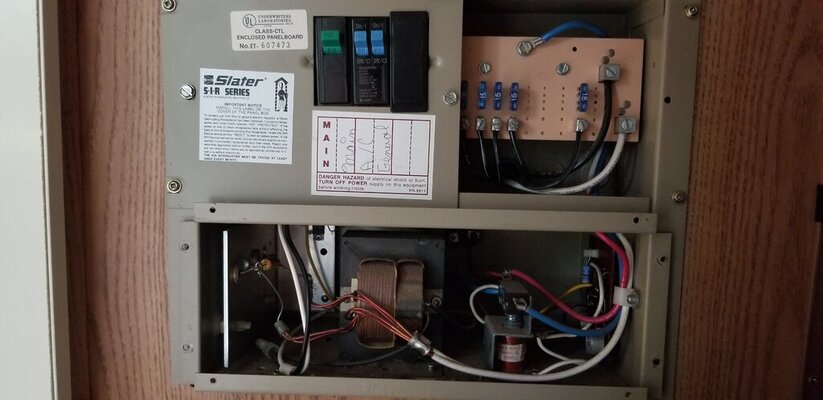WHAT ARE ELECTRICAL FERRULES AND WHEN ARE THEY USED?
If you have ever stripped stranded electrical wire you know the strands can easily get bent out and when you are inserting the stripped wire in wire terminals, under terminal screws, and such, the strands spread out and become flayed. You end up with strands that are not contacting anything and are not doing their job conducting electricity. You can also wind up with situations where the flayed strands can contact other terminals causing shorts and unwanted cross connections.
One way to prevent the strands from going astray is to tin the wires with solder immediately after stripping. This works well, but if you are dealing with a lot of wires, it can become time consuming and requires some care to not cause a fire or damage something with the hot soldering iron or dripping solder. In addition, certain types of terminals have screws that pinch the wire and even when tinned with solder, the screws can nearly cut the wires in-two.
This is where a ferrule comes into the picture. Ferrules are very thin metal sleeves that are a very snug fit on a wire, which is then crimped with a special crimper. Crimpers make square and hexagon shaped crimps and when done properly the sleeve is very tightly attached to the wire.
Some ferrules are all metal, small tubes with a slight flare on one end to make it easier to slide it over the wire, these are non-insulated ferrules. Others have a small insulated “umbrella” on the flared out end to cover the end of the wire. Ferrules come in different wire sizes and lengths.
Crimpers are available that crimp the ferrules into a square shape and others crimp hexagon shape.
Ferrules and crimpers have become more popular and are rather inexpensive. There are some rather expensive models, made by Klein and Knipex that can run $200 or more, but the ones I purchased thru Amazon, complete with an assortment of insulated ferrules were about $25, the crimpers themselves being less than $20.
In the end, I had issues with the insulated ferrules in the kits, they were not long enough, and the insulation sleeve interfered with the installation into the wire terminals on the 12v fuse panel. I searched and found, cleverly named, a company called Ferrulesdirect.com
I determined how long I wanted the ferrules (15mm) and the sizes I needed, 8 gauge, 10 gauge, and 14 gauge, and ordered non-insulated ferrules from them.
For starters, I did the 12v+ wires on the bottom of the Progressive Dynamics fuse panel I had installed over a year ago when I swapped out the converter.
After doing these, I decided to re do the nasty mess at the 12v DC ground bar that is mounted to the floor behind the power panel. The bar was mounted horizontally on a metal Z bracket and that made access to the screw heads difficult with a screwdriver, and an unsightly mess of wires arched up and over to the openings in the bar.
In every case, I cut off the bare end of the wire and stripped it and fitted a ferrule to the wire and crimped it.
I went to Home Depot and bought a section of ½ x ¾ aluminum extrusion and cut and drilled it and smoothed the edges, which allowed me to remount the ground bar vertical, allowing easy access to the screws and allowing the wires to lay flat on the floor, reducing the strain on the wires at the bar. Pictures tell the story.
A trailer or motor home traveling down the road is like your home going thru a magnitude 7 earthquake all the time. All electric and plumbing connections should be checked for tightness every year or so depending on the frequency of use.
The use of ferrules will provide for a “crush proof” connection that will stay tight, while soft copper wire will shake and work, then weaken and break, or compress until it becomes loose.
Though the pictures do not show it, I eventually went back in and cut and stripped the wires on the top of the 12v fuse panel, including the solder tinned converter wires, and installed ferrules on them.
One of the terminals on the fuse panel, the BATT+ terminal had an 8 gauge wire in it, from the battery relay; and also had a 10 gauge wire (charge line) from the 7 pin umbilical that plugs into the tow vehicle. This wire supplied a circuit breaker next to the battery relay and then ran parallel to the 8 gauge battery wire and connected to the same terminal on the fuse panel as the battery wire did. You cannot put two different size wires with ferrules in one connector, it won’t tighten down on the smaller one.
I realized the 5 ft run of 10 gauge was redundant as this wire only serves to charge the battery while driving, and I disconnected both ends of the wire and installed a 6 inch jumper from the circuit breaker to the terminal on the battery relay. Now the electricity travels thru about 10 ft less wire than before to charge the battery, and I only have one wire to deal with in the Battery + terminal on the top of the fuse panel. I checked voltages and circuits to insure I wasn’t doing something wrong. Not sure why BF chose to run the wire the way they did.
To be clear, this change in wiring has no effect on outside trailer lights (brake, running, backup) electric brake circuits, etc, nor does it affect in any way, the operation of ANY 12v DC circuit, it merely shortens the electrical path for charging the trailer’s battery from the tow vehicle.
I hope this gives someone an idea of what ferrules are and how they can be used to neaten electrical wiring and connections, and insure better connections.
Square crimp tool for ferrules
Amazon.com
Hex crimp tool for ferrules
https://www.amazon.com/gp/product/B07MZXWTVQ/ref=ppx_yo_dt_b_asin_title_o06_s01?ie=UTF8&psc=1
A good source of ferrules, both insulated and non-insulated, crimpers, electrical terminals of all kinds and other electrical items
Ferrules Direct











